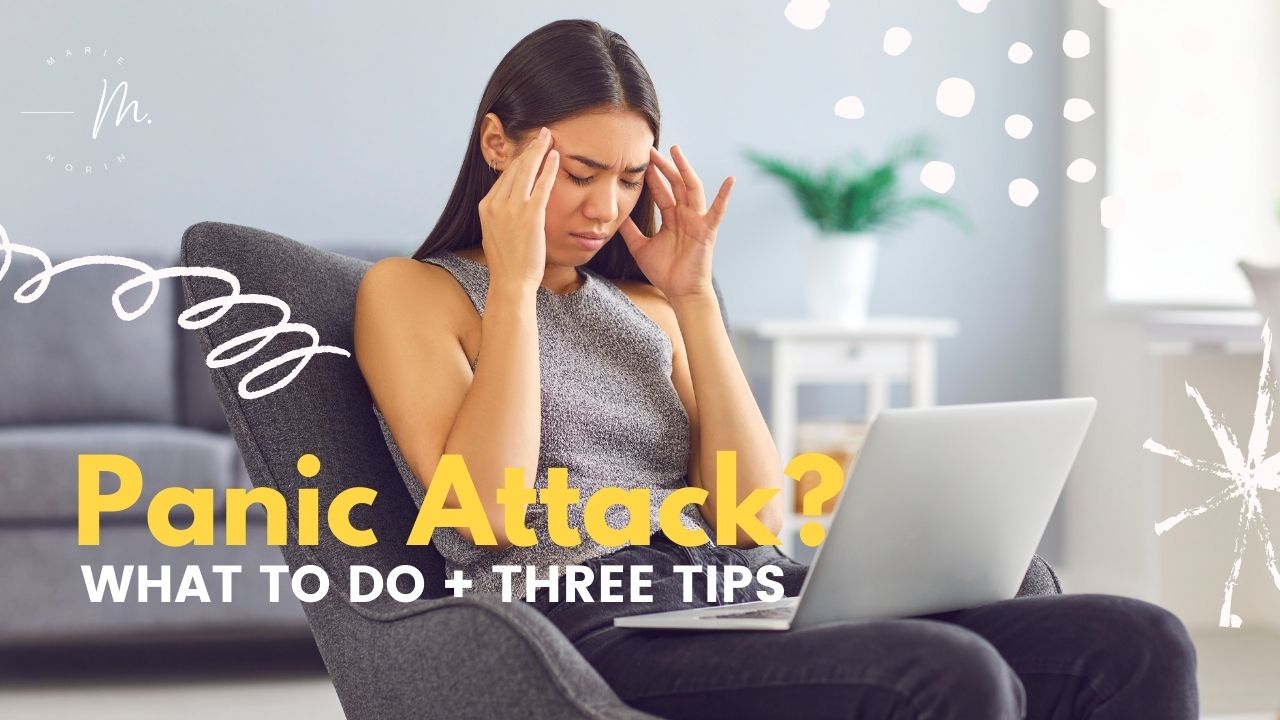Have you had a panic attack with symptoms such as sensations of heart-pounding, sweating, shaking, choking, and feelings of extreme fear and terror? Maybe you felt trembling, shaking, tingling, or nausea. You might have thought you were having a heart attack, stroke or were fearing you might die. No doubt, these are terrifying sensations and thoughts. Fortunately, there are ways to help with fearful thoughts and uncomfortable symptoms. This article covers what to do when you have a panic attack with three techniques to calm a panic attack and learn about the panic cycle.
The Panic Cycle
Panic attacks may happen because of stress or out of the blue. They are sudden onsets of physical sensations and negative thoughts. They can be highly frightening and hard to overcome. Understanding the dynamics of a panic cycle can help you be aware of how it works and what you can do to get through the challenging situation.
A typical panic cycle involves physical symptoms, thoughts, and behaviors. Each of these components relates to and impacts each other.
For example, you may experience the sensation of racing and or pounding heart and then have thought that you have a heart attack. The thought may create more anxiety and then generate more physical symptoms such as tension that releases adrenalin. When adrenalin is released, which signals more fight or flight responses, you may feel more cardiac symptoms such as increased heart rate or pounding heartbeat.
Naturally, being fearful of these symptoms will alert your something dangerous is about to happen thoughts. The cycle continues with accompanying views. Indeed, these thoughts will likely be negative thoughts of impending doom, and the process continues.
Negative thoughts lead to fear, and fear invokes a stress response with more physical symptoms and then reactive behaviors. This process is the panic cycle.
Your behavior may include doing everything you can to escape the uncomfortable feeling. You may also decide you need to avoid different activities if you have another panic attack. Avoidance will not help you. The critical thing to do is to carry on as though everything was normal. You are not in danger, so you need to carry on as you would otherwise.
Be sure to have a thorough medical examination to ensure that a medical condition does not cause the symptoms you have experienced.
Three Tips to Calm Down When Having a Panic Attack
Tip # 1. Do the Self Talk
Remember that you are having a panic attack and that your symptoms are not the result of a physiological problem. Your symptoms are harmless. Keep remanding yourself that you are ok.
Tip #2. Interrupt the panic cycle by doing diaphragmatic breathing.
Diaphragmatic breathing is a technique that allows you to regulate the exchange of oxygen. It will help you not to hyperventilate or chest breathe. You will breathe, bringing air down into your belly by taking in just the right amount of air. Place one hand on your chest and the other on your stomach.
When you inhale, fill your abdomen with air and notice your hand lift. When you exhale, contract your abdomen. When inhaling, count at first saying one and exhaling saying “relax.” You will repeat this until you count to 10 and then begin again. Continue until you feel some relief. Remember to take only enough air.
Remember if this is new to you, it is ok and normal to be distracted. If you do start thinking of other things, start again with patience and kindness towards yourself. Do your best to focus on the breathing, the numbers, and the word relax. It may be hard at first, but you will get better at it if you keep practicing.
Tip #3 Do your best to continue with your activities as planned.
Remember that anxiety about having another panic attack is normal. But you have the tools to manage the anxious thoughts by doing what you normally do. The anxiety over having more panic attacks can often create avoidance of behaviors you would typically do. You want to resist the temptation to avoid your normal activities.
Panic attacks are sudden fearful events that can be highly challenging. When confronted with a panic attack it is very common to head to an emergency room. A thorough physical exam, including tests, will be necessary to determine the cause of your symptoms. If there is no physiological reason for your symptoms, you likely will be told that the experience was a panic attack. You will need four of the following symptoms to qualify as a panic attack.
Symptoms of a Panic Attack
According to the diagnostical and statistical manual 5th edition (DSM-5), four of the following symptoms need to be present to qualify as a panic attack.
- Pounding heart, accelerated heart rate, palpitations
- Sweating
- Trembling or shaking
- A sensation of shortness of breath
- Feelings of choking
- Chest pain or discomfort
- Nausea and or other abdominal distress
- Feeling dizzy, unsteady, lightheaded, or faint
- Chills or heat sensations
- Feeling a tingling sensation and or numbness
- Feelings of unreality (derealization) or being detached from oneself (depersonalization)
- Fear of losing control or going crazy
- Fear of dying
This article discusses the panic cycle that relates the typical pattern that panic attacks create. We discussed three tips to calm down during a panic attack.










